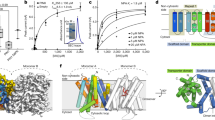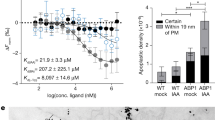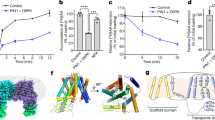Abstract
Polar transport of the phytohormone auxin mediates various processes in plant growth and development, such as apical dominance, tropisms, vascular patterning and axis formation1,2. This view is based largely on the effects of polar auxin transport inhibitors. These compounds disrupt auxin efflux from the cell but their mode of action is unknown3. It is thought that polar auxin flux is caused by the asymmetric distribution of efflux carriers acting at the plasma membrane4. The polar localization of efflux carrier candidate PIN1 supports this model4. Here we show that the seemingly static localization of PIN1 results from rapid actin-dependent cycling between the plasma membrane and endosomal compartments. Auxin transport inhibitors block PIN1 cycling and inhibit trafficking of membrane proteins that are unrelated to auxin transport. Our data suggest that PIN1 cycling is of central importance for auxin transport and that auxin transport inhibitors affect efflux by generally interfering with membrane-trafficking processes. In support of our conclusion, the vesicle-trafficking inhibitor brefeldin A mimics physiological effects of auxin transport inhibitors.
This is a preview of subscription content, access via your institution
Access options
Subscribe to this journal
Receive 51 print issues and online access
$199.00 per year
only $3.90 per issue
Buy this article
- Purchase on SpringerLink
- Instant access to full article PDF
Prices may be subject to local taxes which are calculated during checkout




Similar content being viewed by others
References
Estelle, M. Polar auxin transport. New support for an old model. Plant Cell 10, 1775–1778 (1998).
Berleth, T. & Sachs, T. Plant morphogenesis: long-distance coordination and local patterning. Curr. Opin. Plant Biol. 4, 57–62 (2001).
Morris, D. A. Transmembrane auxin carrier systems—dynamic regulators of polar auxin transport. Plant Growth Reg. 32, 161–172 (2000).
Palme, K. & Gälweiler, L. PIN-pointing the molecular basis of auxin transport. Curr. Opin. Plant Biol. 2, 375–381 (1999).
Hadfi, K., Speth, V. & Neuhaus, G. Auxin-induced developmental patterns in Brassica juncea embryos. Development 125, 879–887 (1998).
Mattsson, J., Sung, Z. R. & Berleth, T. Responses of plant vascular systems to auxin transport inhibition. Development 126, 2979–2691 (1999).
Sabatini, S. et al. An auxin-dependent distal organizer of pattern and polarity in the Arabidopsis root. Cell 99, 463–472 (1999).
Delbarre, A., Muller, P. & Guern, J. Short-lived and phosphorylated proteins contribute to carrier-mediated efflux, but not to influx, of auxin in suspension-cultured tobacco cells. Plant Physiol. 116, 833–844 (1998).
Morris, D. A. & Robinson, J. S. Targeting of auxin carriers to the plasma membrane: differential effects of brefeldin A on the traffic of auxin uptake and efflux carriers. Planta 205, 606–612 (1998).
Michalke, W., Katekar, G. F. & Geissler, A. E. Phytotropin-binding sites and auxin transport in Cucurbita pepo: evidence for two recognition sites. Planta 187, 254–260 (1992).
Cox, D. N. & Muday, G. K. NPA binding activity is peripheral to the plasma membrane and is associated with the cytoskeleton. Plant Cell 6, 1941–1953 (1994).
Bernasconi, P., Patel, B. C., Reagan, J. D. & Subramanian, M. V. The N-1-naphthylphthalamic acid-binding protein is an integral membrane protein. Plant Physiol. 111, 427–432 (1996).
Fujita, H. & Syono, K. Genetic analysis of the effects of polar auxin transport inhibitors on root growth in Arabidopsis thaliana. Plant Cell Physiol. 37, 1094–1101 (1996).
Garbers, C. et al. A mutation in protein phosphatase 2A regulatory subunit A affects auxin transport in Arabidopsis. EMBO J. 15, 2115–2124 (1996).
Ruegger, M. et al. Reduced naphthylphthalamic acid binding in the tir3 mutant of Arabidopsis is associated with a reduction in polar auxin transport and diverse morphological defects. Plant Cell 9, 745–757 (1997).
Fujita, H. & Syono, K. PIS1, a negative regulator of the action of auxin transport inhibitors in Arabidopsis thaliana. Plant J. 12, 583–595 (1997).
Gälweiler, L. et al. Regulation of polar auxin transport by AtPIN1 in Arabidopsis vascular tissue. Science 282, 2226–2230 (1998).
Müller, A. et al. AtPIN2 defines a locus of Arabidopsis for root gravitropism control. EMBO J. 17, 6903–6911 (1998).
Steinmann, T. et al. Coordinated polar localization of auxin efflux carrier PIN1 by GNOM ARF GEF. Science 286, 316–318 (1999).
Klausner, R. D., Donaldson, J. G. & Lippincott-Schwartz, J. Brefeldin A: insights into the control of membrane traffic and organelle structure. J. Cell Biol. 116, 1071–1080 (1992).
Lippincott-Schwartz, J. et al. Microtubule-dependent retrograde transport of proteins into the ER in the presence of brefeldin A suggests an ER recycling pathway. Cell 60, 821–836 (1990).
Wood, S. A., Park, J. E. & Brown, W. J. Brefeldin A causes a microtubule-mediated fusion of the trans-Golgi network and early endosomes. Cell 67, 591–600 (1991).
Satiat-Jeunemaitre, B. & Hawes, C. Redistribution of a Golgi glycoprotein in plant cells treated with brefeldin A. J. Cell Sci. 103, 1153–1156 (1992).
Satiat-Jeunemaitre, B. et al. Brefeldin A effects in plant and fungal cells: something new about vesicle trafficking? J. Microsc. 181, 162–177 (1996).
Satiat-Jeunemaitre, B., Steele, C. & Hawes, C. Golgi-membrane dynamics are cytoskeleton dependent: a study on Golgi stack movement induced by brefeldin A. Protoplasma 191, 21–33 (1996).
Mathur, J., Spielhofer, P., Kost, B. & Chua, N.-H. The actin cytoskeleton is required to elaborate and maintain spatial patterning during trichome cell morphogenesis in Arabidopsis thaliana. Development 126, 5559–5568 (1999).
Lauber, M. H. et al. The Arabidopsis KNOLLE protein is a cytokinesis-specific syntaxin. J. Cell Biol. 139, 1485–1493 (1997).
Völker, A., Stierhof, Y.-D. & Jürgens, G. Cell cycle-independent expression of the Arabidopsis cytokinesis-specific syntaxin KNOLLE results in mistargeting to the plasma membrane and is not sufficient for cytokinesis. J. Cell Sci. (in the press).
Hager, A. et al. Auxin induces exocytosis and the rapid synthesis of a high-turnover pool of plasma-membrane H+-ATPase. Planta 185, 527–537 (1991).
Kategar, G. F. & Geissler, A. E. Auxin transport inhibitors. Plant Physiol. 60, 826–829 (1977).
Acknowledgements
We thank A. Vieten and S. Barth for technical assistance; L. Gälweiler, W. Michalke and K. Roberts for kind gifts of antibodies; S. M. Li for MS/NMR analysis; and M. Godde, M. Heese, T. Hamann, T. Pacher and K. Schrick for helpful comments and critical reading of the manuscript. J. F. was a recipient of a Deutscher Akademischer Austauschdienst fellowship. This work was supported by Deutsche Forschungsgemeinschaft (DFG), Schwerpunktprogramm‘Molekulare Analyse der Phytohormonwirkung’, European Communities Biotechnology Programme and INCO Copernicus Programme (K.P.), and DFG, Sonderforschungsbereich ‘Mechanismen des Zellverhaltens bei Eukaryoten’ (G. J.).
Author information
Authors and Affiliations
Corresponding author
Rights and permissions
About this article
Cite this article
Geldner, N., Friml, J., Stierhof, YD. et al. Auxin transport inhibitors block PIN1 cycling and vesicle trafficking. Nature 413, 425–428 (2001). https://doi.org/10.1038/35096571
Received:
Accepted:
Issue Date:
DOI: https://doi.org/10.1038/35096571
This article is cited by
-
2,3,5-triiodobenzoic acid affects the in vitro propagation of Cedrela fissilis Vell. (Meliaceae) through alterations in endogenous polyamine and indol-3-acetic acid levels and the proteomic profile
Plant Cell, Tissue and Organ Culture (PCTOC) (2024)
-
Arabidopsis seedlings respond differentially to nutrient efficacy of three rock meals by regulating root architecture and endogenous auxin homeostasis
BMC Plant Biology (2023)
-
NSF/αSNAP2-mediated cis-SNARE complex disassembly precedes vesicle fusion in Arabidopsis cytokinesis
Nature Plants (2023)
-
Endogenous Serotonin Accumulation Coincides with Reorganization of Auxin Efflux Protein (PIN1) and Actin (ACT8) Accompanying Primary Root Growth Inhibition in NaCl-Stress-Induced Etiolated Sunflower (Helianthus annuus; cv. KBSH 44) Seedlings
Journal of Plant Growth Regulation (2023)
-
Expression dynamics and a loss-of-function of Arabidopsis RabC1 GTPase unveil its role in plant growth and seed development
Planta (2023)



